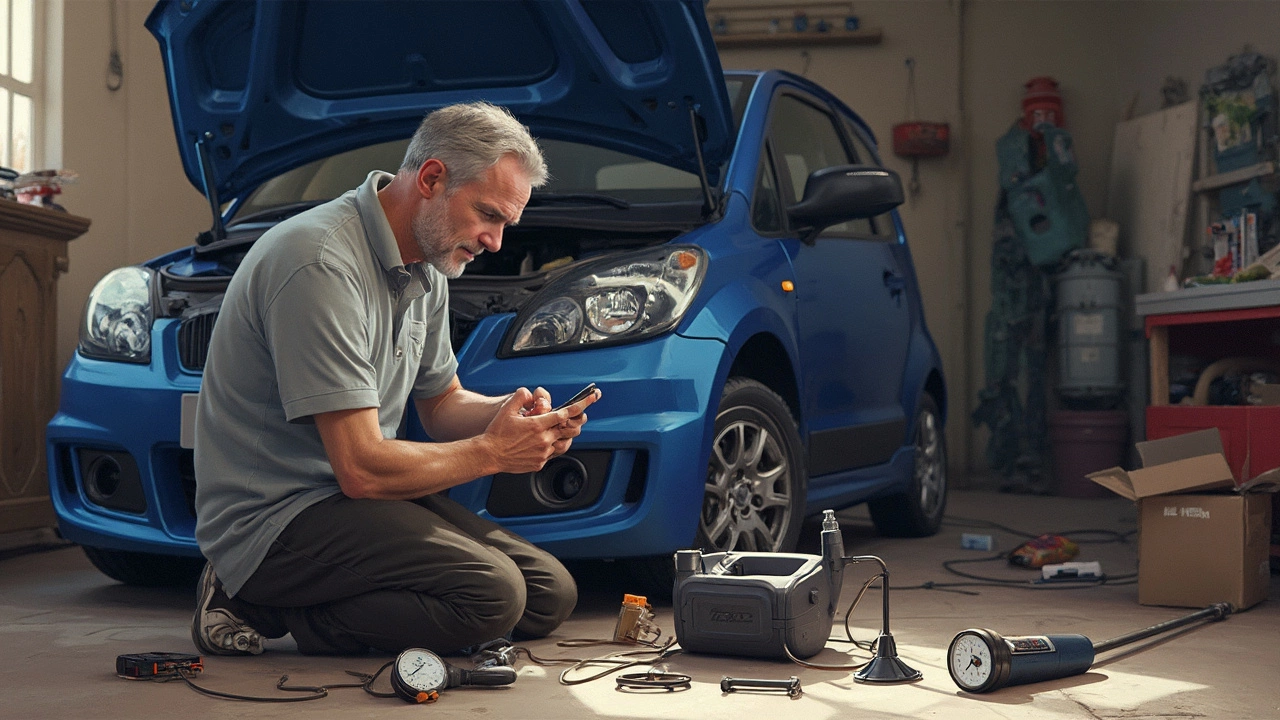If your car sputters, stalls, or just won’t start, your first thought might go straight to the fuel pump. It’s a classic worry. Lots of people swing by AutoZone hoping they can have someone test their fuel pump on the spot—like you do with a car battery. But here’s the truth: AutoZone doesn’t do direct, hands-on fuel pump testing in the parking lot. They don’t hook up machines to your car and tell you if your pump’s shot.
What they can do is help you figure out some basics. AutoZone offers free code scanning, which checks the car’s computer for trouble codes that might point to fuel delivery problems. They're also pretty great at sharing tips, suggesting checks, and showing you where to start if you want to test the pump yourself. Plus, they’ve got loaner tools—stuff like fuel pressure testers that you can use for free with a refundable deposit.
The trick is, a fuel pump isn’t as simple as a battery or an alternator. Testing it usually means getting under the hood (or sometimes under the car), knowing where the fuel rail is, and handling fuel lines safely. If you’re not experienced, you might want to stick to the basic symptoms or have a pro take a closer look. But if you’re handy, the crew at AutoZone will walk you through the process and show you how to use their pressure tester the right way.
- What AutoZone Can (and Can’t) Test
- Spotting the Signs of a Bad Fuel Pump
- DIY Testing Tips for Home Mechanics
- Next Steps If You Need a Fuel Pump Replacement
What AutoZone Can (and Can’t) Test
Thinking about pulling into AutoZone for a quick fuel pump test? Here’s the real deal: AutoZone doesn’t actually hook up your car and run a hands-on test of your fuel pump the way they do with alternators or batteries. There’s no technician on-site who’ll crawl under the hood, connect fuel lines, and diagnose the exact problem for you. It’s just not offered by the chain, and honestly, most auto parts stores shy away from this because messing with fuel systems has safety risks and takes time.
But don’t write them off just yet. AutoZone helps in three powerful ways:
- Free code scanning: They’ll plug in a code reader and check your engine’s computer. If your car throws a code related to fuel delivery (like P0230 or P0087), this step alone can point you in the right direction.
- Loan-a-tool program: Can’t afford a fuel pressure tester? AutoZone lets you borrow one with just a deposit. They’ll even show you how to use it, step by step, with tip sheets or a quick in-person demo if you ask nicely.
- Advice and troubleshooting: The staff are surprisingly helpful—if you mention fuel issues, they’ll walk you through DIY checks, common failure points, and tips for using their tools safely.
Now, what won’t they do? AutoZone won’t physically remove parts, crack open fuel tanks, or repair your car. That type of work is for mechanics. And while they’re happy to test batteries and starters in-store, fuel pump diagnosis is a different animal.
Jeff, a longtime store manager in Nebraska, puts it simply:
“Safety first—fuel pumps mean dealing with gasoline and a lot of pressure. We’ll guide you and loan the tools, but the hands-on part is up to the customer.”
If you want a quick comparison of what they’ll test in-store, check this out:
| Component | Tested at AutoZone? | Free Tool Loan? |
|---|---|---|
| Battery | Yes (in-store) | N/A |
| Alternator | Yes (in-store) | N/A |
| Fuel Pump | No (DIY or by mechanic) | Yes (fuel pressure tester) |
| Starter | Yes (in-store, if brought in) | N/A |
The takeaway? Use AutoZone for advice, free code scanning, and tool loans. But leave the physical fuel pump work for your garage—or a pro—unless you’re comfortable and know what you’re doing.
Spotting the Signs of a Bad Fuel Pump
Before you grab a fuel pump test kit or ask about diagnostics at AutoZone, it helps to know what you’re looking for. Fuel pumps aren’t quiet when they go bad—your car will let you know if it’s struggling to get gas to the engine. Let’s break down some real-world red flags so you don’t chase the wrong problem.
- Hard Starts: If your car cranks for a long time before firing up, that’s a classic fuel pump warning. On morning school runs with my son Jasper, we once spent five minutes hoping the car would finally catch—turned out to be the pump.
- Random Stalling: You’re driving along, maybe stopped at a light, then boom—the engine cuts out even though everything else seems normal. That’s usually the fuel pump dropping pressure out of nowhere.
- Loss of Power Under Load: Going uphill, carrying a load, or just giving the gas pedal a solid push, and the car bogs down? That’s a sign your fuel pump might not keep up with demand.
- No-Start Condition: If the engine’s cranking but never fires up at all, and you know you’re getting spark, a fuel pump is a top suspect.
- Louder Than Usual Whine from the Tank: A healthy fuel pump hums quietly. If you start hearing a loud screech or whine coming from the fuel tank area when you turn the key, it’s probably failing.
Another pro tip: If you have a fuel pressure gauge handy (AutoZone’s loan-a-tool counter usually has one), you can compare your system’s pressure to your car’s spec. If the pressure’s low even with the key on, that’s almost always a bad fuel pump or a clogged filter.
Here’s a quick table showing some common symptoms and what usually causes them:
| Symptom | Possible Cause |
|---|---|
| Long crank/no start | Weak or dead fuel pump, relay issue, clogged filter |
| Engine sputtering at high speed | Worn fuel pump, blocked fuel lines |
| Sudden power loss | Fuel pump failing under load |
| Loud noise from tank | Failing fuel pump bearings |
Catching these symptoms early can save you from being stranded on the side of the road. If any of these sound familiar, it may be time for some hands-on diagnosis or a visit to a pro.

DIY Testing Tips for Home Mechanics
Before you start, make sure you know your way around the basics. Messing with the fuel system can be risky, so work in a well-ventilated spot and keep a fire extinguisher nearby. Safety first, always. If that sounds intimidating, it’s completely okay to call it and ask a pro. But if you’re ready to try, here’s what usually works for checking your fuel pump at home.
The most common way to get to the truth is with a fuel pressure test. You can pick up a fuel pressure tester from AutoZone’s loaner program. Follow these steps:
- Find the fuel rail test port under the hood. Usually, it’s got a cap that looks like a tire valve. Check your car’s manual if you’re not sure.
- With the engine off (don't skip that!), hook up the tester to the port. Double-check the fit so nothing leaks.
- Turn the key to “ON” (don’t start the engine) and watch the pressure gauge. Most cars should show somewhere between 30-60 psi, but always look up your recommended pressure in your specific car’s manual.
- If it’s way low or doesn’t move, your fuel pump might be the problem. If the reading is good, something else may be wrong—like a clogged fuel filter or faulty regulator.
- Remember to release the pressure safely and clean up any spills. Gasoline is no joke.
Here’s a quick table just to give you an idea of typical fuel pressure numbers for different types of cars:
| Type of Car | Normal Fuel Pressure (psi) |
|---|---|
| Most older carbureted engines | 4-7 |
| Modern fuel-injected cars | 30-60 |
| High performance/turbo cars | 50-100 |
If you don’t have a gauge, you can try listening for the fuel pump’s whirring noise. Stand by the fuel tank or fuel filler cap, have someone turn the key to “ON” but not start, and listen closely. If you hear nothing, it could be the pump or just a relay issue. But keep in mind, this isn’t a sure-fire test—it just gives you a clue.
If your fuel pump has gone bad, replace the fuel filter too—otherwise, you could wreck your brand new pump. And always unplug the battery before doing any real work with fuel lines. If you get stuck, bring your info and test results to AutoZone; those folks have seen it all and can give you solid advice or help you find the right fuel pump for your ride.
Next Steps If You Need a Fuel Pump Replacement
So, you’ve checked all the angles and it’s clear—your fuel pump needs replacing. First thing: don’t panic. This is a common car problem, especially on vehicles hitting 100,000 miles or more. Now, let’s run through what you should do next.
Before you dive in, it helps to know that swapping out a fuel pump can be a moderate-to-tough job depending on your car’s make and model. On some rides, the pump is easy to reach right under the back seat. On others, you’ll need to drop the gas tank. Take a breath and see where yours is located.
If you’re thinking of tackling the job yourself, here’s a clear plan:
- Check your owner’s manual or a trusted repair guide to see where your fuel pump is located.
- Gather the right parts and tools. AutoZone can help you find the correct pump for your exact car. Don’t forget new gaskets and maybe a fuel filter, too.
- Pick up—or borrow—a fuel pressure tester to double-check things if you haven’t done that yet.
- Always disconnect your battery before starting. Safety first: fuel is flammable and pressurized.
- Relieve the fuel system pressure following your car’s service guide—it saves a lot of mess and makes things safer.
- Follow the steps to replace the pump. This might mean pulling out your back seat or lowering your gas tank, depending on your vehicle.
- Double check all your connections, then fire it up. Listen for the pump priming and check for any leaks. Done right, your car will start stronger than ever.
Not keen on a DIY repair? No shame in that. Plenty of folks leave fuel pump replacement to the pros. If you go that route, call around for quotes. You might see prices anywhere between $400 to $900 at a shop, depending on labor and your car. Some shops may let you bring your own parts, but always check first.
For a little reference, here’s an idea of what you might expect for replacement times on some common car types:
| Car Type | Average Labor Time |
|---|---|
| Honda Civic (sedan) | 2-3 hours |
| Chevrolet Silverado (truck) | 3-4 hours |
| Toyota Camry | 2-2.5 hours |
No matter which direction you go, replace your fuel filter if it hasn’t been done in a while—it can keep your new fuel pump running longer. And hey, take it easy on low gas—fuel pumps stay cooler and last longer when there’s more gas in the tank. Your future self (and your wallet) will thank you.
